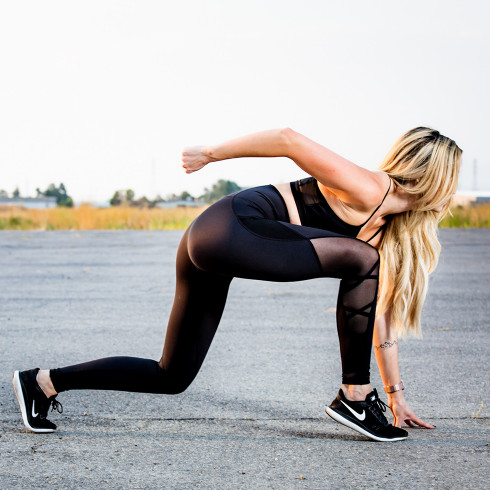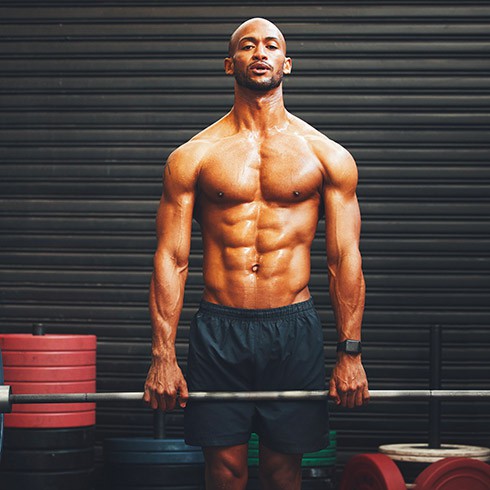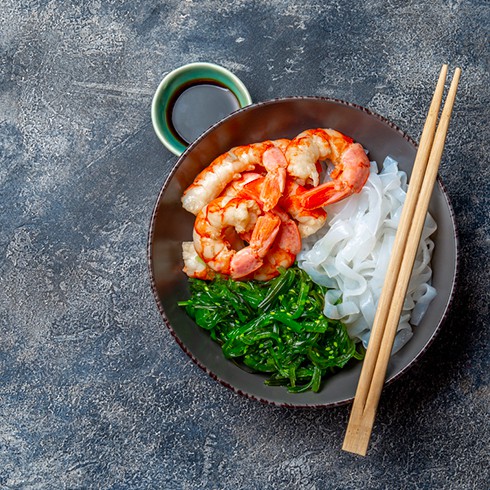Training programme.
So, when you are cutting and you perform workouts similar to those you do during bulking, you are unlikely to break your records. Therefore, you need to adjust your training based on your energy levels :
At the beginning of a cutting phase, do slightly heavier workouts to maintain your muscle mass at its maximum. Then, as calories decrease more significantly and your energy levels drop, reduce your weights and increase your repetitions. Adding isolation exercises can also help to better define specific areas. However, always try to keep some of the heavier exercises at the start of your session.
Indeed, you have two types of muscle fibers :
- White fibers, which are called white because they work without oxygen and are used for shorter, more intense efforts.
- Red fibers, which, on the other hand, work for longer-duration efforts with an oxygen supply.
To stay consistent, you need to maintain muscle in both types of fibers. Therefore, you should vary between short, intense efforts and longer, sustained efforts.
At the beginning of a cutting phase, it’s not too difficult to perform heavier workouts; however, towards the end of the phase, it becomes very challenging, if not impossible.
Examples
You can start your cutting phase with a workout of 10 to 12 repetitions, which is more focused on volume. This will help minimize muscle loss despite the caloric deficit.
As the weights start to decrease due to the lack of carbohydrates, you can increase the number of repetitions if necessary, but always train to failure.
Be aware that when you increase the repetitions, your muscle may experience a burning sensation. You need to push through, continuing until you can barely lift the weight.
You can also vary your cutting workout with programs like drop sets, where you perform multiple exercises for the same muscle back-to-back without rest. You can also use supersets, where you alternate between 2 exercises for opposing muscles, one right after the other without rest.
This type of training can also be varied in several ways, such as with trisets, quadrisets, or giant sets. The goal is to increase the "cardio" aspect of your workout while maximizing its "volume" component.
Exercises
It's often said that for cutting, you should only include isolation exercises. Is this true ?
Let's ask ourselves the following questions :
- Which exercise will require the most energy and therefore burn the most calories ? An isolation exercise or a compound exercise ?
- How does a muscle contraction work in monoarticular versus compound exercises ?
Certainly, a compound exercise will require more energy and effort than a simple isolation exercise, and thus will burn more calories. However, will you still be able to perform it correctly towards the end of a diet? Performing a compound exercise six times with poor form might burn fewer calories than executing an isolation exercise correctly.
Is there a point where isolation exercises become more beneficial for cutting than compound exercises ?
Nothing is proven, but keeping compound exercises in your training for as long as possible is a good way to stimulate muscle volume.
A monoarticular exercise, as the name suggests, involves only one joint, while a compound exercise involves multiple joints.
A muscle contraction depends on the nerve impulses sent to your muscles. The greater the impulse, the more muscle fibers are recruited. Since muscles are made up of muscle bundles, when your body is more defined, the visible fibers may simply be the different bundles alternating during the muscle contraction. At this point, it becomes very useful to allow them to alternate to enhance the "shredded" look of the muscle. Therefore, performing longer sets to highlight the contours of the targeted muscle area will also be beneficial.
Cardio
No one would deny the importance of cardio for tapping into fat reserves.
However, there are also many misconceptions about cardio. Some people believe that cardio is the key to losing the most fat. While it’s not entirely false to say that cardio burns fat, relying solely on cardio will give you a physique similar to a marathon runner: very little muscle and not as defined as a bodybuilder or fitness athlete. The reason is simple. The more cardio you do, the more your body will question the need to carry a lot of muscle mass and will work to eliminate what it considers unnecessary muscle. This is what happens with marathon runners, cyclists, and long-distance athletes. Of course, nutrition plays a role as well, but long, moderate-intensity workouts are more likely to lead to overall muscle loss rather than a well-defined physique.
On the other hand, let's not forget that muscle uses fat as fuel. Therefore, the more muscle you have, the more fat you'll burn.
Therefore, a balance between weight training and cardio is essential for effective cutting. The best solution is: Weight Training + Cardio.
Which cardio ?
Many experts have debated their views on cardio: some believe it's better to do it before training, while others prefer it after; some think cardio should be kept at 60% of your heart rate, while others believe you can increase your heart rate.
What’s the answer ? Let’s ask the right questions.
What fuel in the muscle do we want to eliminate by doing cardio ? Fat, of course.
When do muscles start using fat as fuel? Generally, about twenty minutes after the start of muscular effort. We know that muscles first use intramuscular ATP (adenosine triphosphate) during the initial seconds of contraction. When ATP reserves are depleted, intramuscular creatine takes over. Then, carbohydrates stored in the muscles are used as fuel for up to 15 or 20 minutes after the exercise begins, and finally, fat is utilized.
For any muscle contraction and any exercise, this process always works the same way. This means that if you start your session with cardio, you will deplete the ATP, creatine, and sugars present in your muscles. The same applies if you start your session with weight training.
This logically means that if you start your session with cardio, by the time you get to weight training, your reserves of ATP, creatine, and intramuscular sugars would be depleted! Yet, these are the types of energy you need for an effective weight training session.
However, if you start your workout with weight training, you will quickly deplete your cells of ATP, creatine, and carbohydrates. Therefore, it would make sense that fats are burned more quickly during cardio afterward.
Another misconception about cardio training concerns the intensity of the workout.
You'll often hear that effective cardio should be moderate to target fat reserves. It’s true that since fat is used by the muscles after 20 minutes of effort, as mentioned earlier, it would make sense to do longer and therefore less intense cardio sessions.
However, to replenish ATP, creatine, and intramuscular carbohydrate levels to their normal levels before exercise, the body also requires energy. The more depleted these reserves are, the more energy is needed. This increased energy requirement will also mobilize fats.
It would be reasonable to say that the more intense the cardio effort, the more calories you will burn. Thus, higher-intensity efforts (often referred to as HIIT) may burn fewer fats directly during the exercise but will increase fat consumption during the post-exercise recovery phase.
It’s also important not to confuse cardio with warming up. Warming up is essential whether you're cutting or bulking. It doesn’t need to be intense, but should simply mobilize the joints and tendons to prevent injuries.
Practically, a correct intensity for cardio isn't measured by heart rate, but by your breathing: if you can chat with your neighbor without getting out of breath, your cardio isn't intense enough. And if you use a heart rate monitor, you might find that your heart rate is lower than expected. Increase the difficulty until you can’t talk normally, until your heart rate is high enough to make you feel slightly out of breath.
Examples
A good cutting workout session could be defined as follows :
- Cardio warm-up
- Joint, tendon (flexibility), and abdominal warm-up (4 sets)
- Localized warm-up (exercise for the muscle being worked) 2 sets
- 4x 10-12 reps, compound exercise
- 4x 10-12 reps, compound exercise
- 4x 12-15 reps, isolation exercise
Of course, muscles like the biceps are difficult to train with compound exercises, and this is just an example. At the beginning of a cutting phase, take advantage of having plenty of energy to perform more challenging workouts.
The best sport for losing fat ?
It always comes down to calories burned. The best sport is the one that allows you to burn more calories. Let’s still ask the question: Do you burn more calories running than cycling ?
According to many sports magazines, yes. However, none of these magazines discuss the intensity applied to each activity. It is certain that a professional cyclist will burn more calories in 30 minutes than a casual jogger in the same amount of time.
So, it's not so much the sport you choose but the intensity you put into it that matters. The best sport for you is the one in which you can invest yourself the most !
Conclusions
Don’t hold back, give it your all. Push to failure in each set, without saving yourself for the next one. You’ll feel your limits yourself, don’t impose them on your body.
Sometimes, you might experience dizziness. This is your body’s way of showing its discontent. Sit down, wait for it to pass, and as you progress in your cutting phase, you’ll experience fewer of these sensations. They are just minor hypoglycemias caused by the lack of sugars in your system. It’s also a way for your body to remind you that it doesn’t like changing its habits. Once these new habits become the norm, it will no longer complain.
There is no special "recipe" for cutting training, except for "Give it your all !"
Related posts
-
 Losing weight: basic concepts.
Posted in: Perdre du poids07/06/2023Every year, just before the summer, magazine adverts for diets are a big hit. And every year, thousands of people...Read more
Losing weight: basic concepts.
Posted in: Perdre du poids07/06/2023Every year, just before the summer, magazine adverts for diets are a big hit. And every year, thousands of people...Read more -
 Nutritional Programme Guide.
15/02/2024There's nothing easier than losing weight. The only difficult thing is making the decision. If you have a lot of...Read more
Nutritional Programme Guide.
15/02/2024There's nothing easier than losing weight. The only difficult thing is making the decision. If you have a lot of...Read more -
 Necessary food supplements and vitamins.
Posted in: Perdre du poids01/01/2021Many supplements can help you when you want to do cutting. However, always pay close attention to their calorie...Read more
Necessary food supplements and vitamins.
Posted in: Perdre du poids01/01/2021Many supplements can help you when you want to do cutting. However, always pay close attention to their calorie...Read more -
 Ideas for dishes.
Posted in: Perdre du poids01/01/2021When you have the feeling that your stomach is never full with your diet, that you're always hungry, konjac is an...Read more
Ideas for dishes.
Posted in: Perdre du poids01/01/2021When you have the feeling that your stomach is never full with your diet, that you're always hungry, konjac is an...Read more -
 Common mistakes to avoid.
Posted in: Perdre du poids01/01/2021Try to vary your food, to bring different sources of protein and carbohydrates to your body. When you stop cutting...Read more
Common mistakes to avoid.
Posted in: Perdre du poids01/01/2021Try to vary your food, to bring different sources of protein and carbohydrates to your body. When you stop cutting...Read more
Blog categories
Popular posts
-
 Looking thinner but at a heavier weight? Is that possible?04/10/2021Posted in: Our tipsAdvertising has shaped our thinking! We have been forced for years to believe that losing weight is the key to having...Read more
Looking thinner but at a heavier weight? Is that possible?04/10/2021Posted in: Our tipsAdvertising has shaped our thinking! We have been forced for years to believe that losing weight is the key to having...Read more -
 Proteins for weight loss !29/12/2023Posted in: Our tipsDive into the fascinating world of proteins and their key role in weight loss. Discover how to choose the best...Read more
Proteins for weight loss !29/12/2023Posted in: Our tipsDive into the fascinating world of proteins and their key role in weight loss. Discover how to choose the best...Read more -
 Which foods boost testosterone levels ?07/05/2021Posted in: Food supplementsTestosterone, often associated with virility, has much more to offer than you might think. It plays a crucial role in...Read more
Which foods boost testosterone levels ?07/05/2021Posted in: Food supplementsTestosterone, often associated with virility, has much more to offer than you might think. It plays a crucial role in...Read more -
 10 BENEFITS OF GLUTAMINE.02/01/2024Posted in: Our tipsDiscover the power of L-glutamine, an underrated superhero in the world of amino acids! Essential for revitalizing...Read more
10 BENEFITS OF GLUTAMINE.02/01/2024Posted in: Our tipsDiscover the power of L-glutamine, an underrated superhero in the world of amino acids! Essential for revitalizing...Read more -
 Is there a link between sex and sport?14/11/2019Posted in: LifestyleMany have already asked questions about sex and sport. Most of the time, people want to be reassured by the many...Read more
Is there a link between sex and sport?14/11/2019Posted in: LifestyleMany have already asked questions about sex and sport. Most of the time, people want to be reassured by the many...Read more





